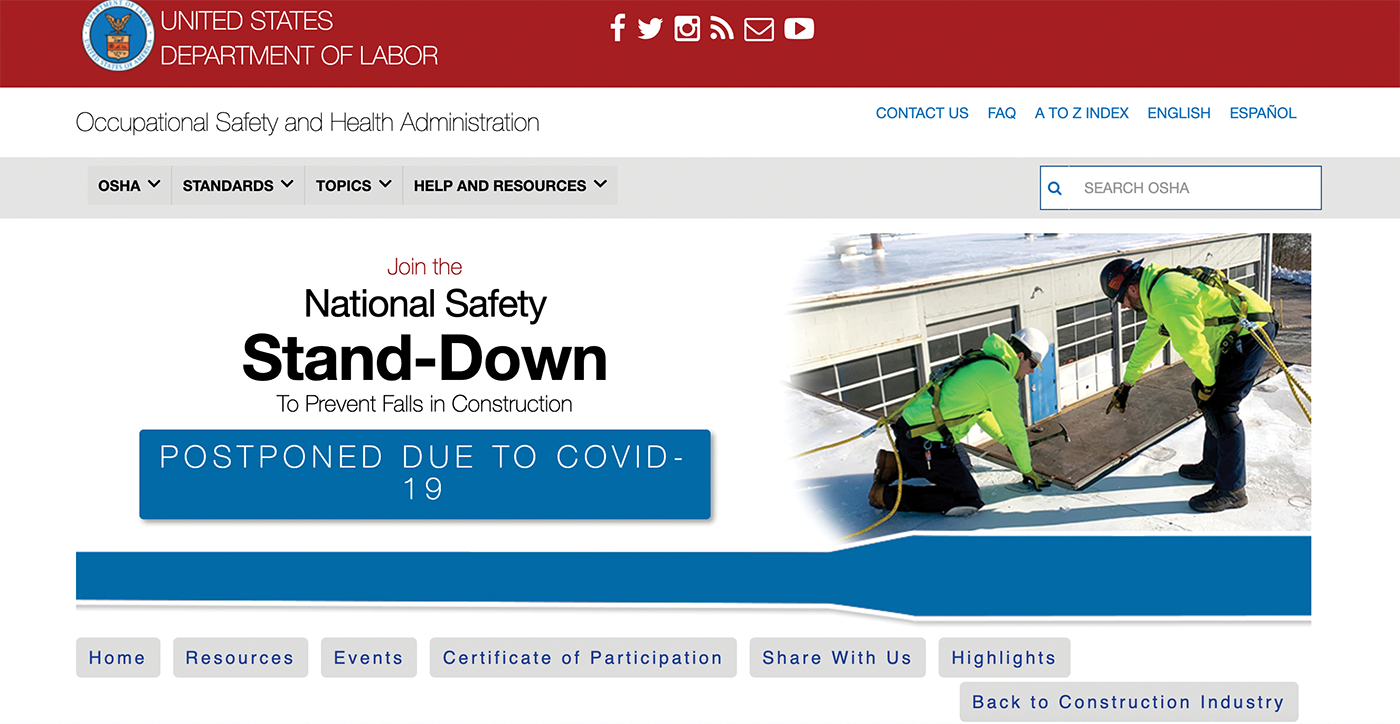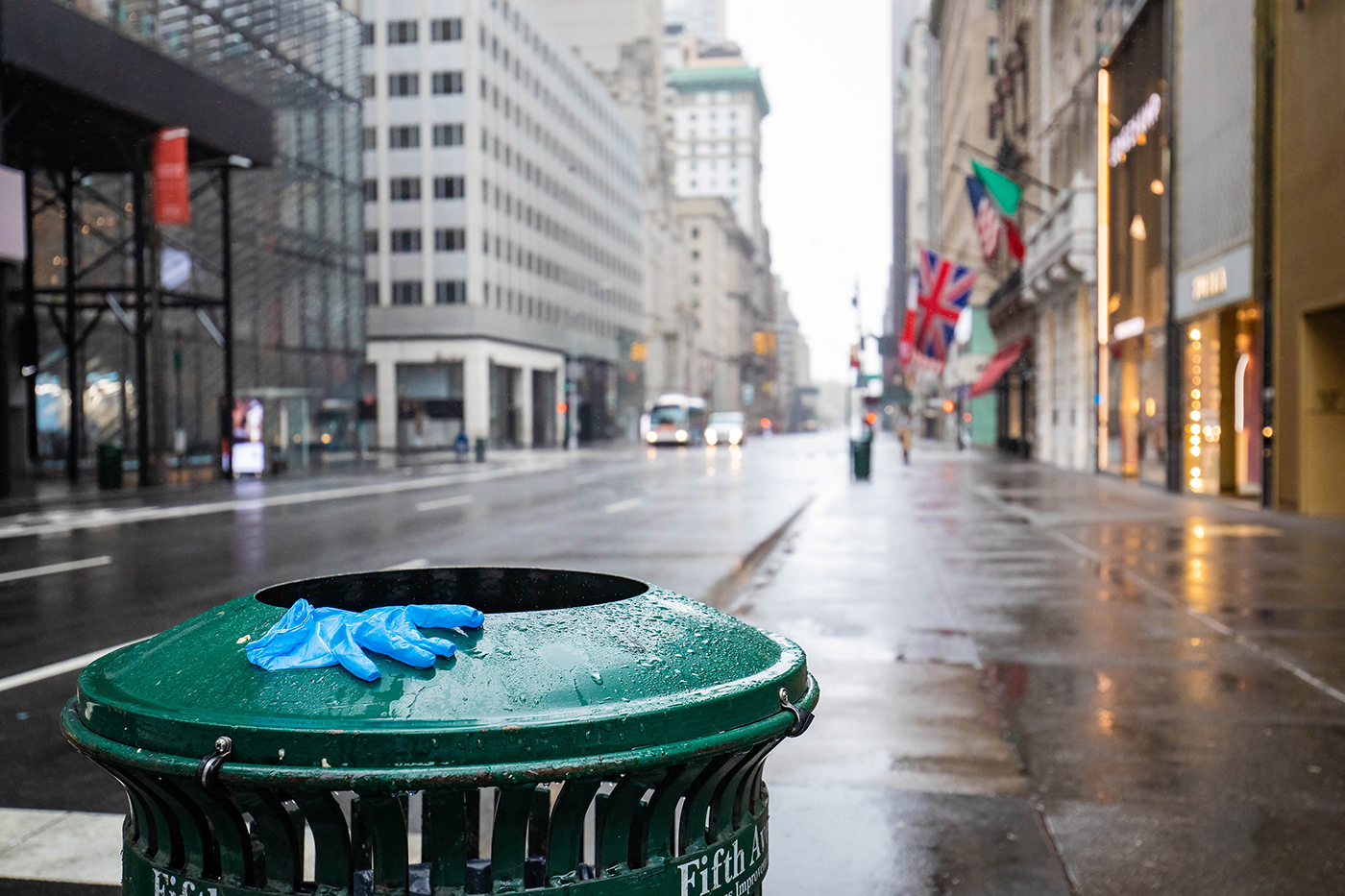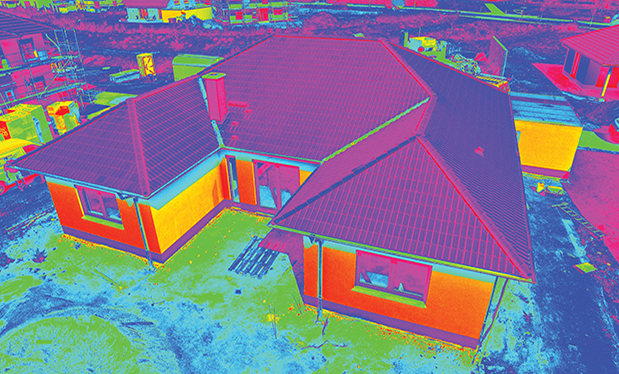OSHA postpones annual safety stand-down

|
The Occupational Safety and Health Administration has postponed the seventh annual National Safety Stand-Down to Prevent Falls in Construction, originally scheduled for May 4-8, because of the COVID-19 pandemic. The event will be rescheduled this summer.
Falls remain the leading cause of fatal injuries to workers in the construction industry. Although the National Safety Stand-Down is postponed, OSHA encourages employers to remain vigilant and use all available resources to enhance worker safety, including resources at www.osha.gov/stopfallsstanddown.
NRCA ProCertification® components now available remotely
NRCA has announced NRCA ProCertification candidates may now take their computer-based exams remotely—in English and Spanish—using Prometric’s ProProctor™ remote testing service. The new service allows authorized candidates to take their computer-based exams anywhere that meets specific remote-testing requirements, including at home. Candidates must pre-schedule taking their exams directly with Prometric.
NRCA ProCertification, NRCA’s national certification initiative, enables experienced workers who demonstrate substantial roofing skills and knowledge to become certified by NRCA in specific roof system installations. Roofing contractors are encouraged to make the most of this unprecedented time to get their experienced installers and foremen started on their paths to NRCA ProCertification. Additional information about NRCA ProCertification, including answers to frequently asked questions and readiness resources, is available at www.nrca.net/procertification.
In addition, NRCA has announced eligible roofing professionals now can complete the NRCA ProCertification Qualified Assessor program remotely. This opportunity is only available for a limited time.
Qualified Assessors evaluate the hands-on performance of roof system installers seeking NRCA ProCertification. Qualified Assessors work independently and generate revenue by charging NRCA ProCertification candidates an appropriate fee for conducting their performance exams; gain access to NRCA ProCertification materials, including educational content, resources, manuals, policies and procedures, and testing locations; and become experts in all aspects of NRCA ProCertification. Additional information, eligibility requirements and applications are available at www.nrca.net/qualifiedassessors.
IRS provides information about Employee Retention Credit

|
Under the Coronavirus Aid, Relief, and Economic Security Act, or CARES Act, the Department of the Treasury and IRS have launched the Employee Retention Credit, which is designed to encourage businesses to keep employees on their payrolls.
The refundable tax credit is 50% of up to $10,000 in wages paid by an eligible employer whose business has been financially affected by COVID-19.
Additional information, including answers to frequently asked questions, is available at www.irs.gov/newsroom/faqs-employee-retention-credit-under-the-cares-act.
Construction companies furlough workers amid COVID-19 crisis
The COVID-19 pandemic is causing construction companies to layoff and furlough employees, according to www.constructiondive.com.
As of April 3, 27% of construction firms responding to an online survey conducted by the Associated General Contractors of America said they had furloughed or terminated workers as a result of the COVID-19 pandemic; that number increased to 40% by April 10.
Respondents said the furloughs and layoffs are tied to a slowdown in construction work, and 30% of firms said they had been asked by government officials to shut down construction sites. In addition, 53% of respondents said their projects have been delayed by owners, and another 7% said owners had canceled their projects.
The survey found contractors are facing various issues related to COVID-19, including materials shortages, personal protective equipment shortages, potential infected workers, lack of government action and a shortage of craftworkers.
About 22 million U.S. workers filed for unemployment during the past few weeks. Associated Builders and Contractors Chief Economist Anirban Basu says employment reports in upcoming months are likely to be worse. He also said it is unclear how much of the employment declines are resulting from mandated suspension of projects in states and how much are because of the emergence of recessionary forces.
“Generally, nonresidential construction is one of the last segments of the economy to enter recession as contractors continue to work down their collective backlog,” Basu says. “The need for social distancing renders that statistic less pertinent, meaning that nonresidential construction is susceptible to large-scale job losses immediately.”
New York construction shutdown adds to debt risk

|
New York City’s construction shutdown has affected a $66 billion industry, increasing the risk on billions in loans issued for projects throughout the city, according to Bloomberg Law.
Before the COVID-19 crisis, more than 450 construction projects were underway citywide, and lenders originated about $8 billion in construction debt during the past two years. With nonessential workers ordered to stay home at least through May 15, contractors and vendors may not survive, and lenders, such as Wells Fargo, are wondering whether they will get paid.
Construction projects already in progress are at risk of losing financing, says Jonathan Roth, managing partner at 3650 REIT, a Miami-based commercial real estate lender. Highly leveraged lenders may not be able to continue to fund obligations regarding construction loans, which typically are provided during the life of a project. If delays cause a loan to go out of balance, a lender may decide to force a capital call or provide a grace period for the borrower.
Transit-related infrastructure projects and work on hospitals and affordable housing are the only construction projects deemed essential under New York’s shutdown order.
Trust within organizations leads to increased profits, retention
Autodesk Inc., in partnership with management consulting firm FMI Corp., released findings from an industry study, “Trust Matters: The High Cost of Low Trust,” according to www.wfmz.com. The study measured the costs and benefits of different levels of trust within construction organizations and across construction project teams.
FMI and Autodesk surveyed more than 2,500 construction professionals worldwide who ranked trust within their organizations, ranging from “very low” to “very high.” The rankings were assessed against respondents’ reports of their organizations’ internal performance, culture and external relationships.
Although the findings reveal organizations with “very high” levels of trust achieve better financial and organizational performance, 63% of survey respondents reported their organizations have less than “very high” trust. Compared with organizations with lower levels of trust, “very high” trust organizations generate more repeat business, retain more employees and drive a higher level of operational success.
Key findings were that respondents from the highest trust organizations revealed performance advantages that can add up to millions of dollars of profitability each year, including more repeat business, lower voluntary turnover and timely project delivery. Organizations with the highest trust also generate more employee engagement, value collaboration and build stronger relationships externally.
The study also revealed common, measurable attributes foster trust and positively affect performance across construction organizations, such as consistent internal processes, transparent communications, environments where employees feel safe and secure sharing their views, and a focus on employee development.
Inspector general is reviewing OSHA’s silica enforcement
The Department of Labor’s inspector general has begun an audit of the Occupational Safety and Health Administration’s enforcement of rules limiting worker exposure to silica dust, according to Bloomberg Law.
Assistant Inspector General for Audit Elliot Lewis did not specify the concerns that prompted the audit in his Feb. 14 letter to OSHA. The audit follows a similar inspector general review of the Mine Safety and Health Administration’s efforts regarding silica exposure.
Ten days before receiving the inspector general’s letter, OSHA had announced a revival of its national silica enforcement emphasis program, which now involves calls for at least 2% of OSHA inspections to target silica—potentially leading to more than 640 federal inspections per year. State-run programs covering private-industry workers must implement similar efforts.
The silica rules were issued in March 2016; construction companies had a June 2017 deadline to comply, and manufacturers had a June 2018 deadline. OSHA said the previous program was withdrawn in 2017 because it had become outdated after the new silica rule’s enactment. On Sept. 11, 2019, OSHA announced it would initiate a new silica emphasis program.
During fiscal year 2019, OSHA issued 837 citations for alleged silica rule violations with proposed fines totaling $1.4 million; this does not include violations cited by state agencies covering private-industry workers.



